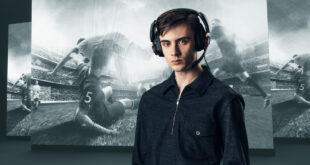Stafford Bawler’s work for the creators of Monument Valley – London-based Ustwo – has secured him a coveted nomination in this year’s Develop Awards.
“I’m absolutely blown away,” says Bawler. “The game reviews and feedback on the audio have been incredible. The whole thing has been really inspiring and has also proved a valuable learning experience.
“From the get-go, Ustwo were clear the audio should be light, ambient, positive and uplifting. The player’s viewpoint is a high-up isometric view – kind of remote – making you lean towards treating the sounds as if they’re sort of miniaturised, but actually, these are full-scale structures and the main character you see walking around. Princess Ida, is a normal sized human being, so these are absolutely massive monuments.
“I started out creating background ambiences based on realistic sounds – and this extended to my approach for materials, say stone-dragging sounds for large slabs of marble sliding against each other, but over
a period we realised I was chasing my tail a bit – looking for better and smoother material sounds and more perfect ambience. It became apparent something more abstract was needed, including sounds with musical tonality (with music being the ultimate abstract sound).
“The result was that both individual object sounds and the ambient backdrop became very musical and harmonious – and the more we went on, the less we wanted audio realism. With this principle established, my design approach was completely unlocked and I focused on the mood and story-telling for each chapter. It became a more artistic and compositional kind of approach.”
The audio elements were implemented using Tazman’s Fabric plug-in for Unity, enabling Bawler to run the most recent build of the game and manipulate and edit the audio in real-time.
“This was my first time working with Unity and Fabric, so it took a bit of time to get used to the Unity Environment and the way Fabric ordered things. However, all the usual audio middleware conventions were there.
“With Fabric it’s almost like FMOD and Wwise had a baby and I really like theparent-child hierarchy structure Fabric uses, which fitted well with my way of working.
“Early on in the project I was able to lay out an ordered structure of mix groups and audio systems with relative ease. The way Fabric dynamically handles the various links between game objects and named events is very forgiving and flexible as well, so I was able to change things around when needed without much fuss or the need to track down broken links. This is great when you realise there’s a better way of ordering things within an established audio system some way in to the project.”
Smooth fabric
Bawler adds that one particular aspect of the implementation he enjoyed was how Fabric works inside the Unity editor environment alongside the rest of the objects and code.
“As long as the Fabric events have been hooked up, any changes you make can be heard immediately – as soon as you run the game. The removal of the step of having to build the audio for a game, then either drop
it into a runtime location or check into source control (and wait for a build) made the overall integration process quicker and smoother.
“I was also able to make changes to the audio whilst the game was running, although because I was working with the audio structure as a Unity prefab, there was one small drawback – the changes you make aren’t preserved when you stop the game running. This means you have to note what tweaks you’ve made and then apply them to the prefab, which can lead to headaches if you forget to make notes – but isn’t a problem once you’re aware of this little idiosyncrasy.”
The whole project was integrated into a GitHub server using Sourcetree to manage iteration. “Ustwo was able to hear my changes as soon as they were ‘pushed’, meaning we had a pretty fast feedback cycle even though I worked remotely,” says Bawler.
“This also meant we could try out ideas and demo stuff very quickly as well. Monument Valley is a puzzle game but it’s also a journey – there’s an experience there. It was conceived as almost like a work of art that you could hang on your wall – yet you can interact and play with it too. Creatively speaking, working on this title has definitely made me take a step back and think about music and sound design for games a little differently.
“When I’m working with composers in future, and when I’m involved with musical fx creation again, right from the design stage, I’ll be taking a more holistic approach.”

 MCV/DEVELOP News, events, research and jobs from the games industry
MCV/DEVELOP News, events, research and jobs from the games industry


